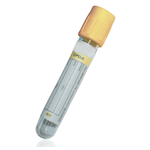Sample Processing in Laboratory
Usual
Sample Preparation
Centrifuge
Turnaround Time
2 DaysSample Stability
Serum and EDTA plasma are suitable for this assay.
Samples are stable for 7 days at 4ºC or 3 months when stored at -20ºC.
Bile Acids
General Information
Bile acids are synthesised in the liver, secreted into the bile, reabsorbed from the intestine, transported by the portal blood to the liver and then actively reabsorbed with a certain spill-over into the systemic blood flow. As such they are characterised by the fact that they undergo enterohepatic circulation.
Increased levels in fasting or post-prandial state are considered a specific indicator of liver disease. A decreased level indicates bile acid malabsorption, possibly due to ileal dysfunction. Serum total bile acids are increased in acute hepatitis, chronic hepatitis, liver sclerosis, liver cancer and obstetric cholestasis.
Patient Preparation
None
Notes
Extremely lipaemic and icteric samples may give misleading results. No significant interference from haemolysis.
As bile acids are increased after meals, fasting samples should be used
Reference Range
<6 μmol/L
Source : Abbott Diagnostics
Results greater than 20 μmol/L must be telephoned – telephone to Delivery Suite if ANC not available. If patients are in the community they will be telephoned by the midwives and asked to attend for a CTG and assessment, so that the need for treatment can be assessed.
Specifications
- EQA Scheme?: Yes
-
EQA Status:
RIQAS and WEQAS
